I decided to ask the students to look at the woods through the eyes of a worm-eating warbler. Worm-eating warblers (here's one of my drawings of a female tending her nest)
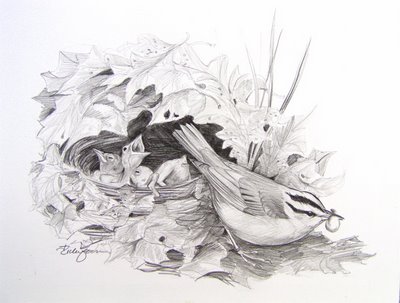 specialize in finding insects, spiders, egg sacs and larvae hiding in hanging dead leaf clusters. Until you look at the woods through a worm-eating warbler's eyes, you'd never dream how many hanging dead leaf clusters you could find to plunder for food. So I asked the kids to think like a bird, a bird which makes its living clinging upside down to dead leaf clusters, looking for whatever lives inside them. We went from cluster to cluster, prying them apart and seeing what was inside. And there was a spider or an egg sac in nearly every one. Calls of "I found one!" rang out through the golden woods. And then came the call from Caitlin Adams: "I found a BAT!"
specialize in finding insects, spiders, egg sacs and larvae hiding in hanging dead leaf clusters. Until you look at the woods through a worm-eating warbler's eyes, you'd never dream how many hanging dead leaf clusters you could find to plunder for food. So I asked the kids to think like a bird, a bird which makes its living clinging upside down to dead leaf clusters, looking for whatever lives inside them. We went from cluster to cluster, prying them apart and seeing what was inside. And there was a spider or an egg sac in nearly every one. Calls of "I found one!" rang out through the golden woods. And then came the call from Caitlin Adams: "I found a BAT!"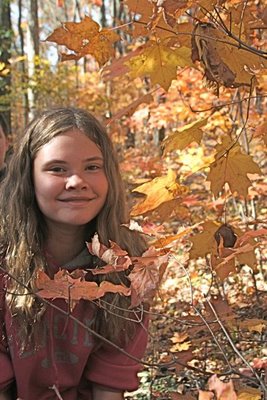
Everyone froze and hurried over to Caitlin's side. She had indeed found a bat, hanging upside down right beside a leaf cluster. Well, how about that! A bat. A BAT!! And not just any bat, but a Red Bat. My Favorite Bat of All. One I have seen countless times, but only on the wing. Oh, how I have longed for a better look at a red bat. And now, thanks to Caitlin and Mrs. Newman and Clermont Northeastern Middle School which owns these beautiful woods she helped to save from the lumber mill, here was a red bat hanging right at eye level from a sugar maple leaf for all the world to see.
Lasiurus borealis is one of the tree bats, family Vespertilionidae. Red bats occur across the eastern two-thirds of North America, and they are more common than you'd think, but they don't live in colonies; they're solitary. They migrate south just like birds when it gets cold, though with their luxuriant cinnamon-colored fur, they have much greater cold tolerance than most other bats. In Ohio, we see them most often in late October and early November, as they make their way south. If you see a bat flying around alone on a cool autumn evening, or even during bright daylight in fall, it may be a red bat. They roost, often hanging by one foot, and look remarkably like a hanging dead leaf or pine cone. Females may have up to five young at a time, and she flies with them clinging to her belly, and when they're old enough to hang up she leaves them hanging while she forages, then flies back to nurse them. Imagine a female red bat hanging her babies up and then coming back to nurse them. It's a scene right out of Stellaluna. Red bats are actually pretty large bats, as bats go, with a body length of around four inches and wingspans of up to 13". When it's really cold they ball themselves up inside their furry tail membrane, looking like almost nothing at all.
Gently, I tipped the leaf so the kids could see the bat's face, and the weakened leaf petiole, about ready to let go anyway, snapped off in my hand. After a moment of panic--I have a bat in my hand! What am I going to do with him now? Unhook his feet and hang him up somewhere else?-- it occurred to me that in the 100 or so pockets of the kids surrounding this bat there might be a bread wrapper or a piece of string. Sure enough, Tierra pulled a bit of blue yarn out of her jeans pocket. Another student held the leaf while I tied the yarn around the stem and then around a twig on the little maple tree. Voila. The bat was safely hanging once again. Phewww.
It is hard to overstate the concentrated cuteness of a red bat. Hanging head down, he didn't look like much. Maybe like a hamster, with that unusual cinnamon brown, silky fur.
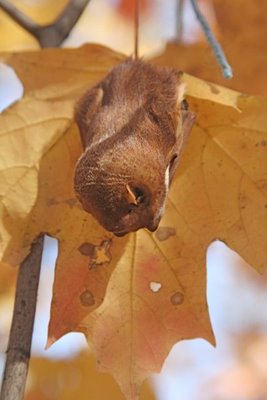 But I insisted that even the kids who were a little shy about bats come forward and have a look at his face.
But I insisted that even the kids who were a little shy about bats come forward and have a look at his face.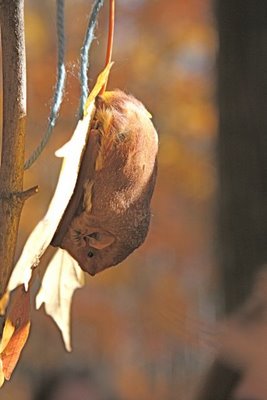 And it was there, eye to eye, that the true connection between these kids and this bat was forged. It is impossible to be afraid of an animal this adorable, no matter how bad the advance press on bats might be.
And it was there, eye to eye, that the true connection between these kids and this bat was forged. It is impossible to be afraid of an animal this adorable, no matter how bad the advance press on bats might be.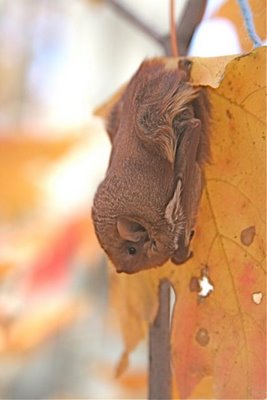 Along his side, just above the wing, was a stripe of creamy fur that seemed almost too lovely to be true. We all wanted so badly to stroke that satin fur, but we didn't want to scare him any more than we already had. For those who have internalized all the myths about bats and who recoil in horror at the thought of touching one, rest assured that no one but me got closer than a hand's length to the animal, and I stayed with it as long as the students were present.
Along his side, just above the wing, was a stripe of creamy fur that seemed almost too lovely to be true. We all wanted so badly to stroke that satin fur, but we didn't want to scare him any more than we already had. For those who have internalized all the myths about bats and who recoil in horror at the thought of touching one, rest assured that no one but me got closer than a hand's length to the animal, and I stayed with it as long as the students were present.You have been warned. The bat pictures in this post will increase in adorability until your face melts.
Every once in awhile he'd raise his head and look around in wonder at all the faces staring back into his.
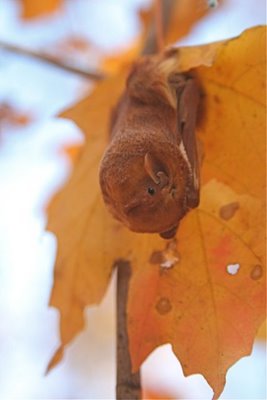
Once, when we got a little too close, he gaped at us, a little warning, but even that was pretty cute.
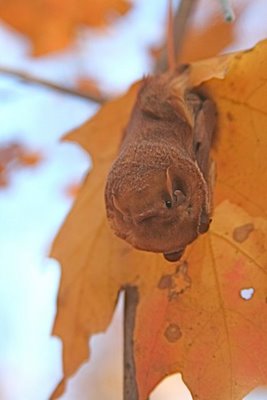
All the while, I told the kids what I knew about red bats. The nice part for me was that we ignored, never deigned to mention, skipped completely over the old wives' tales about bats--that they get tangled in your hair, that they all carry rabies, that they are evil, bloodthirsty, black-hearted flying mice...none of which are true, and none of which obviously applied to this enchanting little creature. No, we leapt right to the infatuation phase in our relationship with this bat.
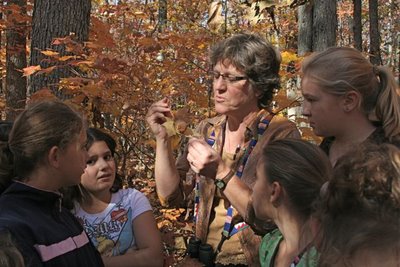
Everyone wanted their picture taken with the famous red bat (who looks like a chicken nugget in this picture, hanging right in front of one kid's face on the left side of the photo). I wish I could post all my pictures, and I apologize to anyone who was there but feels left out. There were permissions forms involved...it got complicated. Thank you, Sherri and the other teachers and students who raced to get written parental permission, for making publication of these photos possible.
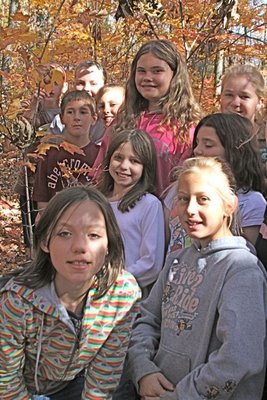 Caitlin the Bat Locator is the tall girl in pink, and Tierra's right in front of her, in white. She gave me yarn, and reminds me of hauntingly of my niece, Christy. I had to stop myself from scooping her up and hugging her.
Caitlin the Bat Locator is the tall girl in pink, and Tierra's right in front of her, in white. She gave me yarn, and reminds me of hauntingly of my niece, Christy. I had to stop myself from scooping her up and hugging her.Although cellphones aren't supposed to come out during school hours, Mr. Blake
made an exception. It's not every day you get to say hello to a red bat.
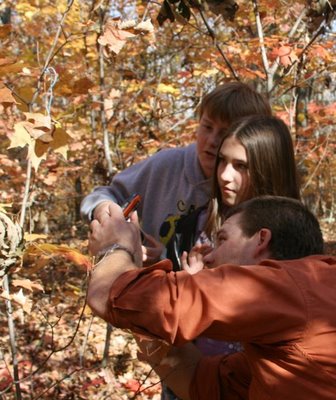
A whole bunch of photos later, it was finally time to turn back toward school. We'd no sooner gotten in the doors than Mr. Blake gathered several teachers and headed back out to show them the little vespertilionid. That was one of my favorite moments of the day. I had no sooner returned from my third field trip than I turned right around and took a fourth, impromptu group out to see it. Then Sherri Newberry took two more groups. It was that special, that irresistible. The whole school caught red bat fever that golden November day.
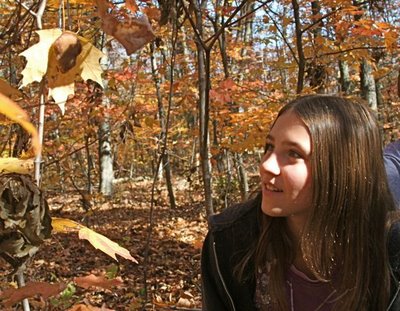 Bridget was so completely enchanted that she couldn't leave. I knew a girl like that once.
Bridget was so completely enchanted that she couldn't leave. I knew a girl like that once.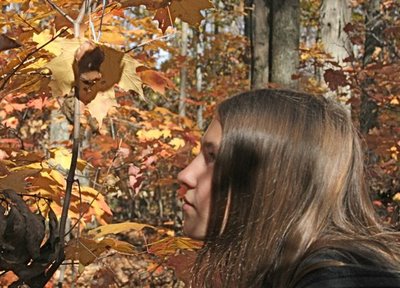
I don't know what she'll become when she grows up, but something rare passed between Bridget
and the bat. I would imagine that teachers never get used to seeing a life change before their eyes, and that's what keeps them working and grading papers long into the night.
Thank you to Pam Murphy, Sherri Newberry, Melody Newman and Stephen Blake for making my visit so rich and for preparing the students so well, so that they could hear what I had to say. Thank you to Nick Adams for building the blind, and to his younger sister Caitlin for finding the bat. (Coincidence? I think not). Thank you to the students for loving the bat every bit as much as I did, for being willing to look into its face, to connect with its small furry soul and imagine what it must be thinking and feeling. Thank you for reading my work and looking at my paintings and photographs, and for the nice messages you've sent me. And thank you to Clermont Northeastern Middle School for protecting the pond and woodlot, for these seemingly simple landscape features provide habitat for all creatures great and small, and by their presence afford limitless opportunities for learning and spiritual renewal to your students.
I have yet to see a parking lot or a pile of lumber that can do that.
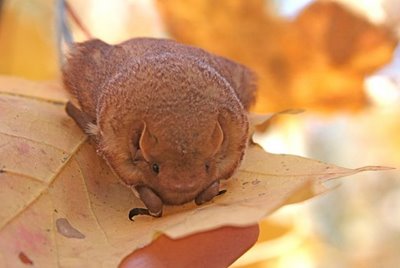






37 comments:
Oh my, I'm all vuhklempt! What a wonderful day this must have been for those kids, and for you. Keep on spreadin' that love and appreciation for all things nature to kids (little ones and big ones!) far and wide, Julie.
lovely!
I am wondering why wouldn't the bat have flown away rather than face all that attention?
Btw, "Silverwing" by Kenneth Oppel is a wonderful, wonderful young adults fiction book about the mysterious and magical lives of bats. Very recommended for young and not-so-young readers alike.
What a magical experience that must have been for all! I can't imagine how hard it must have been not to stroke its beautiful fur.
Bat Conservation International has these wonderful little pocket sized "Interesting Bat Facts" cards that I buy every fall to hand out with candy on Halloween.
He's so much plumper than I would have thought! Or maybe his dense coat makes him seem that way.
At any rate, what a find!
And what perfect timing, to be able to share such a rare moment with so many at that impressionable age.
You just never know what may come of it.
Certainly, good things.
I am enchanted by your posts and photos, and this two part report of your day with the school children is marvelous! Thanks for the photos of the bat; I, too, would have been fascinated to see it. This experience (the sum total of the day, not just the bat) will be something these children will remember for their lifetimes. Kudos to you, and to the school administrators, teachers and friends who made this day possible.
what a beautiful creature! thanks for sharing!
Great educational opportunity and you controlled the situation properly. We had an unfortunately uncontrolled bat situation in our local grade school a few weeks ago. A parent brought a dead bat into the school to show her kids classes (kindergarten and third grade I think.) The kids rushed to the classroom door to see the bat and were allowed to handle it! Then it was discovered that the bat had been killed by a cat and the cat now tested positive for rabies. That caused a major flap at the school. A large number of kids had to receive the rabies vaccination series. Access to classrooms by outside visitors is now severely restricted. Too bad. What started as natural history education turned sour. I congratulate you for your thoroughness in keeping the kids and the bat safe.
Neat! Neat! Neat!
Caroline in the Black Hills
That bat is just chock-full of smooshy cuteness! Much prettier than any little brown bat I have ever met. (And, the attic of my college dorm was home to a group of bats, so I have lots of experience with them!)
~Kathi
Julie, thank you so much for the special day spent with us. It was one of those magical days of teaching that you never want to end. We were very excited today when we read your post. My students are very inspired to start their own hand at nature blogging. I wrote a grant to do just that after getting hooked on your blog last year.Now my students are also hooked. What a great way to teach writing!It is so exciting to see everything come together.
Thank you everyone for kind words. It is wonderful to know that others appreciate and value the lessons learned through exposing students to nature.
Fantastic story and great pics Julie. I would have loved to see that bat! I'm going to keep my eyes out for those dead leaves.
Speaking of verklempt...thank you, Melody. Thank you.
I'm sitting in a dimly lit open-ear shelter in Guyana, having spent the entire day exploring some AMAZING habitats--saw a brilliant orange bird called the Guianian Cock-of-the-Rock--one I've wanted to see my whole life--and photographed a giant otter at very very close range...among other incredible experiences. What a day. Your note just caps it off.
Thanks again for this rare opportunity to touch some lives.
Now that I have stopped bawling, and now that I have read your entire Red Bat blog aloud to my husband (the former middle school biology teacher), I must just write and say--THANK YOU.
Thank you for caring about children so much, for caring about red bats so much, for caring about teachers so much--for caring about this marvelous marvelous world we live in.
What a wonderful day. Thanks for sharing it with us all.
"Every once in awhile he'd raise his head and look around in wonder at all the faces staring back into his."
About this post - the way you relate to the kids, your tribute to them and their teachers, all put tears in my eyes.
Bravo, Julie.
True learning.....priceless...and untestable (in the traditional NCLB way)!
dallas
True and wonderous learning...priceless...and untestable in the usual NCLB way!
Lessons learned in those woods that day will stay with them forever. That is what good teachers do... share passion and love of the subject, thus imparting knowledge that is timeless. Indeed, it will be interesting to see what paths some of the kids take having had experiences like they've had at CNMS. Bravo to the staff and to you Julie for sharing the love.
What a wonderful post!!! Eye Candy for all. You have changed my thoughts about bats. I knew they are good for our environment and I have quite a few around my house. Now I will not get so nerved up the next time they make their way into my house.
I applaud you and teachers who make a difference and I'm proud to say my son and daughter in law are among you.
Thanks for sharing this. Those are some lucky kids!
Wow. As a teacher (in one of those urban-education-barracks buildings that have no sunlight or growing things... sigh) I have to say your post(s) left me in tears. What an opportunty. What a magical day for everyone! I am sure each of those students will remember this as something very special.
Well done.
Great photos. It is amazing what you find if you really look. Excuse me while I go look for bats!
Thanks!
What a neat story. I'm glad the kids got a chance to see and learn about the red bat. Hopefully their appreciation for nature will stay with them for the rest of their lives.
It is so rejuvenating to exeprience a day like this; even second hand! This was just the balm I needed and at just the precise moment I needed it. When work and jobs and insurance and health and sibling rivalry and real estate woes have you stuck in the glop of everyday worries, a red bat and an inspired school is just the remedy.
Thanks a million for shaking me back into place and giving me some very enjoyable perspective!
Julie, I love bats and just wanted you to know how much I enjoyed reading this and getting a closer look at one. I don't know my bats, but the ones we see at dusk at our cottage are dark and not so cute.
Good, I'm glad this all turned out well for everyone--you, the students (who had a wonderful wildlife opportunity) and the bat. I sincerely wish we were just "internalizing myths" about handling bats, but no, it's a real problem that requires some genuine consideration. Here's the web site from the Ohio Department of Health that has the numbers for 2007 just in Ohio:(http://www.odh.ohio.gov/ASSETS/3FD4AEC0392745B382CE5943DFB0818B/rabsum.pdfut).
While there were no human rabies cases in Ohio that year, over 40 people wound up having rabies prophylaxis due mostly to exposure to bats later proven to carry the virus. It doesn't take a deep bite wound to spread the disease--indeed most bat exposures leading to human disease involve very tiny, minor punctures. While not a valid sampling of the bat popultion as a whole, about 5% of bats submitted to ODH for rabies testing are positive, and come from all over the state. That does NOT mean that 5% of bats have rabies, but the number is trying to tell us that the virus is widely distributed, and given the lack of understanding of the disease in bats it is wise to be careful.
In this case, all turned out well, but if cute Mr. Bat had plopped into your hand, turned around and bitten or scratched you (he didn't, right?)you'd be getting rabies prophylaxis now (not quite as bad as everybody imagines)or, at very least, beautiful little red bat would be a preserved brain getting tested for the virus. Not good for anybody.
The point here is not panic, but to realistically understand what's happening. It's amazing how much misinformation (or really just misunderstanding of the statistics)is out there, dissemminated by both wildlife advocates and others--no small amount in otherwise authoritative wildlife publications. Look at it this way--you know better than to screw around with a wild raccoon, skunk, or fox that looks like it needs attention; it's wise to take the same attitude with bats, too; sad but true, they are responsible for the big majority of human rabies exposure and actual cases of human rabies (though very few) in the US.
Sorry to be so preachy, but in your case I would recommend two things: 1)always have some gloves with you, and 2)for someone in your field, consider having the rabies pre-exposure prophylaxis shots.
Thanks, I'm done!
Geez, big "Dr. Know-it-all", but can he spell "disseminate"? Nooo.
Also, that whole Web address for the wildlife rabies statistics didn't come through--just Google "Ohio Department of Health Rabies 2008" and you'll find the page with the numbers. @008 statistics are appearing, too--they appear to be a bit higher than 2007 so far.
What a wonderful story! Thank god those kids got a chance to experience something like this at least once in their lives. And blessings upon the folks who saved those woods from the lumber mill, too.
I laughed when you said this was your first time seeing a red bat up close. I can't believe I beat you to that! One year we had a lone red bat, possibly young and a little confused, perching on the carvings at the old Huntington Building in downtown Columbus. He was at eye level, if you can believe it, and was there for the better part of a week. I visited him every day, although I tried to be unobtrusive lest someone hostile to bats realize he was there. He was so precious, in all senses of the word.
what an awesome find. i work as a naturalist with kids almost every day in the spring and summer here and looking at nature with kids is always an inspiring experience that i am so grateful for. we've seen many, many wonderful things over the years but no bats hanging out like that, just flying about at dusk--that must have been so cool! great pics, too
I was a girl like Bridget. I still am in many ways, and I still wonder if I should go back to school and study biology, although I'm 28!
I just came back from Mexico where we would watch the bats every night. They were very large bats, flying from one side of the walkway to the other, catching bugs that were attracted to the streetlamps. It was pretty incredible to watch - the bats would come within inches of us and it was the most amazing feeling. I'm glad that you were able to share that with those students - they'll definitely remember that moment for a long time!
Your new blog format had a Red Bat photo when refreshed, so here I am (and the blog search worked!) ...it's incredibly moving to see one of these little fellows alive. I worked with so, so many dead ones at the wind farm. Reds were 3rd most common, but so fantastically shaped and colored. Anyway, thank you for posting the facial feature shots; that's what people need to see!
Holly, if you can use those adorable bat photos in any way to help their plight, please contact me. Go to the bottom of the blog homepage and click the Mother May I link. I'd love to hear more about red bats and windfarms, and your work.
Best,
Julie
When I saw the photo of Bridget as the cover for the blog post on Fb, I swear I thought it was a photo of YOU long ago, gazing at a bat! XO
This post had me in tears . II's so rare that today's kids get to connect with nature. And to get to be in your presence made for a much bigger connection. I bet several lives were changed forever that day. I love to get to help with the environmental education at some of the national wildlife refuges - I get to see kids make these connections with Nature. I also had an Outdoor Club in an inner city school and got to give kids their first views of nature. Powerful medicine for them and me.
Intelligent, respectful, curious and she passes it on and on and on.
You made this old man, bat lover, and teacher cry.
Post a Comment